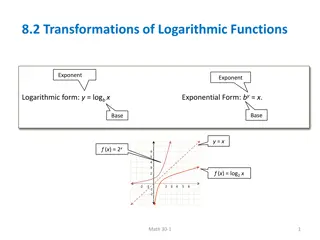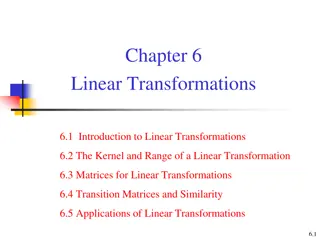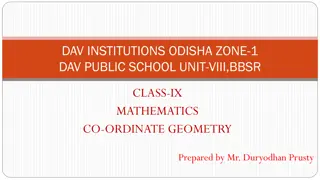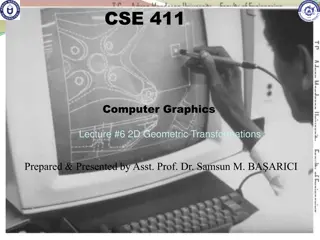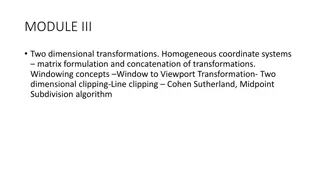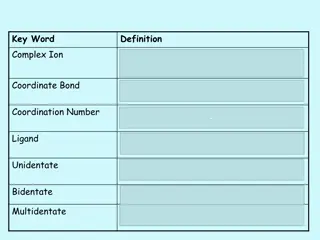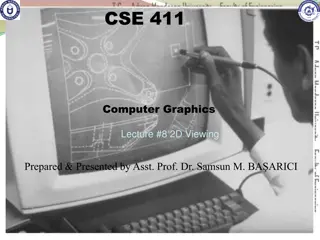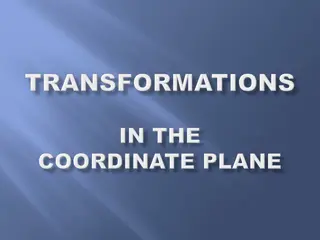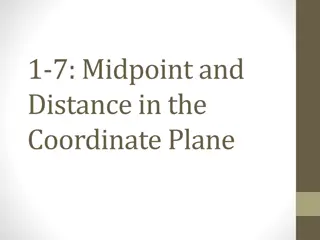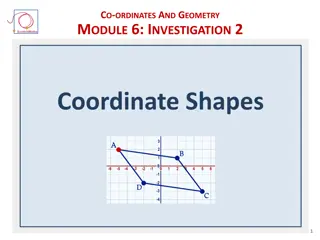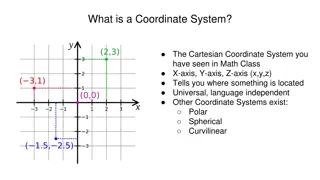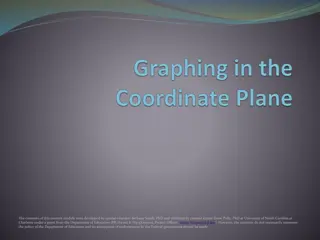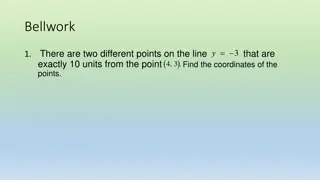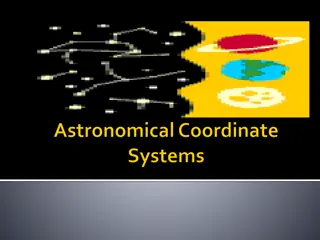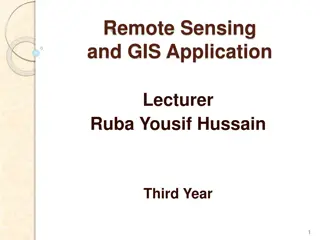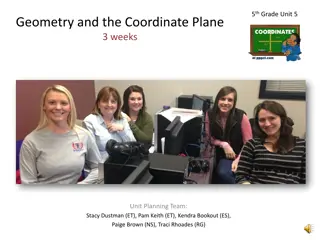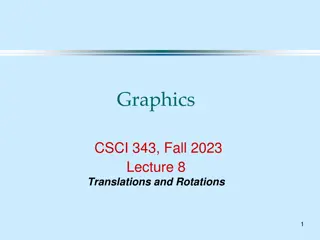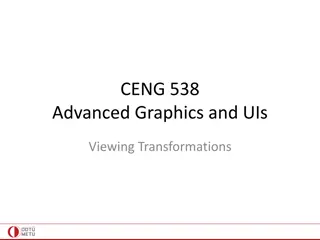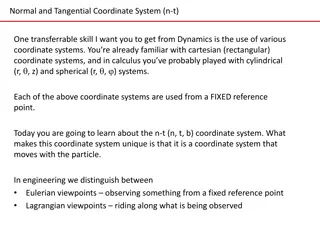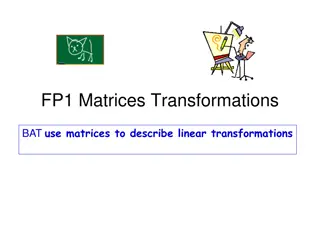Logarithmic Function Transformations
Explore transformations of logarithmic functions through examples involving vertical and horizontal stretches, translations, and reflections. Understand how to sketch the graphs of logarithmic functions and determine missing coordinates on the graphs. Additionally, learn about transformations such a
4 views • 9 slides
Linear Transformations and Matrices in Mathematics
Linear transformations play a crucial role in the study of vector spaces and matrices. They involve mapping vectors from one space to another while maintaining certain properties. This summary covers the introduction to linear transformations, the kernel and range of a transformation, matrices for l
2 views • 85 slides
Coordinate Geometry in Mathematics
Coordinate geometry, a system developed in 1637 by Descartes and Fermat, allows for locating points in a Cartesian plane using x and y coordinates. This concept involves recalling coordinate axes, plotting points, understanding quadrants, and solving real-life problems. The history, introduction, an
4 views • 27 slides
2D Geometric Transformations for Computer Graphics
In this lecture on 2D Geometric Transformations, Assistant Professor Dr. Samsun M. BA ARICI covers topics such as translation, rotation, scaling, homogeneous representations, and coordinates. The lecture delves into basic transformations like reflection and shearing, as well as practical application
3 views • 81 slides
2D Viewing Transformations and Windowing Concepts
Exploring two-dimensional transformations, homogeneous coordinate systems, matrix formulation, and concatenation of transformations. Concepts like windowing, window-to-viewport transformation, viewing transformation, and the 2D viewing pipeline are discussed with relevant images and explanations.
6 views • 38 slides
Complex Ions and Coordinate Bonds in Chemistry
Complex ions in chemistry are formed when transition metals or their ions bond with ligands through coordinate bonds. Ligands utilize their lone pairs of electrons to form dative covalent bonds with transition metals, determining the coordination number of the cation. Complex ions play a crucial rol
2 views • 29 slides
2D Viewing in Computer Graphics
Exploring the concept of 2D viewing in computer graphics, this lecture covers the 2D viewing pipeline, including clipping, window normalization, viewport transformations, and OpenGL 2D viewing functions. It explains how a picture is defined using a Cartesian coordinate system, selecting views within
5 views • 84 slides
Transformations in Coordinate Plane
Learn about transformations in a coordinate plane, including translations, rotations, reflections, and dilations. Discover methods to perform translations and understand how to determine the new prime points. Explore examples and step-by-step instructions to master the concept of transformations.
3 views • 9 slides
The Coordinate Plane: Unit 1 Lesson 12
Engage in learning about the coordinate plane, axes, quadrants, and coordinates to accurately position points and understand their locations in this comprehensive lesson. Practice naming quadrants and interpreting ordered pairs to navigate the coordinate plane effectively.
2 views • 22 slides
Midpoint and Distance in Coordinate Plane
This content covers the concepts of finding midpoints and distances in the coordinate plane. It explains how to calculate the midpoint of line segments on a number line and in a coordinate plane using the midpoint formula. Additionally, it discusses finding the distance between two points using the
1 views • 7 slides
Coordinate Shapes Investigation: Module 6 Activity 6.2.1
Explore coordinate geometry and shapes in Module 6 Investigation 2 Activity 6.2.1. Learn how to build scripts for sprites, spell words using coordinates, and complete coordinate challenges with letters. Get hands-on experience with letters, coordinates, and grid points within a fun and interactive l
0 views • 27 slides
Creating Coordinate Systems in Creo Parametric
Learn how to create a coordinate system in a specific location and orientation within a Creo Parametric assembly. Follow step-by-step instructions to set external references, activate the desired widget, and redefine the coordinate system without external dependencies. Enhance your design process by
0 views • 11 slides
Coordinate Systems in Mathematics and Astronomy
Coordinate systems such as Cartesian, Polar, and Celestial serve as frameworks for locating points in space. They include dimensions like x, y, z axes in Cartesian, Latitude and Longitude on Earth, and various systems for astronomical observations. Different coordinate systems cater to specific purp
0 views • 11 slides
The Coordinate Plane and Graphing Techniques
Explore the basics of the coordinate plane, including quadrants and graphing ordered pairs. Learn how to identify the x and y coordinates, plot points accurately, and graph polygons in the coordinate plane. Enhance your understanding of geometry and spatial reasoning through practical examples and v
1 views • 8 slides
Geometry in the Coordinate Plane
The content discusses various topics related to geometry in the coordinate plane, including finding points on a line that are a specific distance apart, classifying polygons by their sides, determining perimeters of polygons with given vertices, and calculating areas of triangles and polygons. It pr
0 views • 12 slides
Horizontal Coordinate System in Astronomy
Explore the Az/Alt and Equatorial coordinate systems in astronomy, based on the celestial sphere surrounding Earth. Learn about azimuth, altitude, cardinal directions, and how coordinates change with locations. Understand the components, measurements, and directions used in the horizontal coordinate
1 views • 15 slides
Coordinate Systems, Map Projections, and GIS Applications
Explore the intricacies of Geographic Coordinate Systems, Projected Coordinate Systems, and different types of map projections as part of the Remote Sensing and GIS Application course taught by Lecturer Ruba Yousif Hussain in the third year. Dive into the properties of map projections like conforman
2 views • 13 slides
Geometry and Coordinate Plane in 5th Grade
Delve into the world of geometry and the coordinate plane with 5th-grade students. The unit focuses on graphing on the coordinate grid, properties of shapes, real-world problem-solving, and numerical patterns. Students will classify shapes, plot points, and explore multiplication and division concep
1 views • 15 slides
Graphics Output Primitives and Coordinate Reference Frames
Graphics output primitives and coordinate reference frames play a crucial role in describing scenes and drawing basic geometric structures in 2D space. These concepts involve defining points, drawing lines, and understanding pixel coordinates within a coordinate system. Absolute and relative coordin
5 views • 35 slides
Change Coordinate
This content covers various topics in mathematics such as coordinate systems, vector transformations, equations of ellipses, and hyperbolas. It delves into the concepts of basis vectors, matrix-vector products, and different coordinate systems like Cartesian and other systems. Explore the methods to
0 views • 12 slides
Triangles and Rectangles on Coordinate Grids
The coordinate grid presents various lines and shapes like triangles and rectangles. Explore finding areas of triangles, lengths of line segments, and equations of intersecting lines on the grid. Practice coordinate geometry concepts with these interactive problems.
0 views • 20 slides
Composable Sound Transformations of Nested Recursion and Loops
This academic research explores the composable nature of sound transformations involving nested recursion, loops, dynamic instances, iteration spaces, scheduling transformations, and more. The study delves into loop interchange, loop tiling, polyhedral model usage, traversal techniques like blocking
0 views • 25 slides
Geodesy, Map Projections and Coordinate Systems
Delve into the world of geodesy, map projections, and coordinate systems, understanding the shape of the earth, various map projection techniques, and the significance of coordinate systems in spatial data analysis. Learn about spatial references in ArcMap, transforming between coordinate systems, a
0 views • 61 slides
GCSE Transformations of Functions
This resource covers fundamental concepts of transformations of functions in GCSE mathematics, including function rules, input-output relationships, and graph transformations. It explores how changing inputs affects outputs and how to apply transformations to functions. Practice problems and visual
0 views • 23 slides
Transformations on the Coordinate Plane
Transformations on the coordinate plane involve movements of geometric figures through reflections, translations, dilations, and rotations. By identifying each transformation correctly, you can understand how figures shift, expand, or rotate in relation to a given point or line.
0 views • 27 slides
Transformations in Computer Graphics: Matrices & Functions
The world of transformations in computer graphics through the manipulation of matrices and functions. Learn how to scale, rotate, and translate objects efficiently using concatenated transformations. Dive into the intricacies of creating and applying transformation matrices in WebGL with the help of
0 views • 18 slides
Coordinate Geometry: Line Solutions Revision
In this section, you will find solutions and exam-style questions related to coordinate geometry focusing on lines. Topics covered include determining values, investigating perpendicular lines, finding equations of lines passing through points, and plotting points. The explanations provided will hel
0 views • 81 slides
Introduction to Loop Transformations in Compiler Optimizations
Delve into the world of compiler optimizations with a focus on loop transformations. Explore the significance of high-level optimizations, parallelism, and data locality. Understand the impact of loop transformations on program performance and learn why they are crucial for achieving faster executio
0 views • 61 slides
Advanced Graphics and UIs Viewing Transformations
In the realm of computer graphics, mastering viewing transformations is crucial for positioning objects in a 2D image based on a camera's perspective. This process involves camera, projection, and viewport transformations, transitioning from backward to forward rendering pipelines. Discover the esse
0 views • 35 slides
NGS Coordinate Conversion and Transformation Tool (NCAT) V2.0
NCAT is a comprehensive solution for coordinate conversion and transformation, modernizing geodetic toolkit as part of NSRS modernization. It offers multiple ways of access, supports various coordinate systems, uses NADCON and Vertcon for transformation, and provides APIs for integration with other
0 views • 15 slides
Curvilinear Motion: Understanding Normal and Tangential Coordinate Systems
Learn about normal and tangential coordinate systems (n-t) used in dynamics. Explore how these systems differ from fixed reference point systems, and their significance in fluid dynamics and engineering applications. Gain insights into the Eulerian and Lagrangian viewpoints and their role in modelin
1 views • 15 slides
Translating, Rotating, and Reflecting Objects on a Coordinate Graph
Practice transforming objects on a coordinate graph by translating, rotating, and reflecting them. Visualize the transformations and create designs using basic shapes. Explore challenges involving patterns on a coordinate graph.
0 views • 5 slides
Three-Dimensional Coordinate Transformations and Rotations Explained
Uncover the intricacies of transforming vectors in three dimensions, exploring rotation matrices, orientation principles, and smooth motion challenges with a focus on coordinate systems. Understand the linear transformations between Earth and Platform coordinates, the importance of orthogonal matric
0 views • 16 slides
Coordinate Conversion and Transformation Tool: NCAT V2.0
NCAT V2.0 is a comprehensive tool for coordinate conversion and transformation, offering multiple access options, API vs. download choices, and support for geodetic to projected coordinate conversion. It also includes transformation features using Nadcon 5.0 and Vertcon 3.0. Explore how NCAT can str
0 views • 15 slides
Lorentz Transformations and Velocity in Special Relativity
Explore the theory of special relativity with a focus on Lorentz transformations, energy, momentum, and electromagnetic field transformations. Understand the complexities of velocity transformations in moving frames and the concept of velocity 4-vector in the context of physics.
0 views • 19 slides
Using Matrices for Linear Transformations: Concepts and Applications
Explore how matrices can describe linear transformations and solve transformation problems by finding the image of points under specific transformations. Learn about properties of linear transformations, representing transformations with matrices, and transforming shapes using matrix operations.
0 views • 15 slides
Transformation Definitions with Coordinate Pairs
Explore various transformations such as mapping, translating, enlarging, reflecting, and rotating shapes using given coordinate pairs. Understand how to locate invariant points and identify vertex invariance during transformations.
1 views • 5 slides
Understanding Coordinate Systems in Electromagnetic Field Theory
Explore the cylindrical and spherical coordinate systems in Electromagnetic Field Theory, including their relationships with rectangular coordinates. Learn how to convert between different coordinate systems for practical applications in electrical engineering.
1 views • 9 slides
Understanding Coordinate Geometry Basics
Explore the fundamentals of coordinate geometry, from identifying points in a plane using ordered pairs to defining the Cartesian plane with coordinate axes. Learn how to assign coordinates, sketch regions, and calculate distances between points in this introductory session." (280 characters)
0 views • 9 slides
Coordinate Plane Transformations Review Quiz
Explore the concepts of transformations in the coordinate plane with definitions and examples of key geometric terms like circles, points, angles, perpendicular lines, parallel lines, and more. Test your knowledge with questions on angles, functions, symmetry, and triangle types.
0 views • 25 slides
